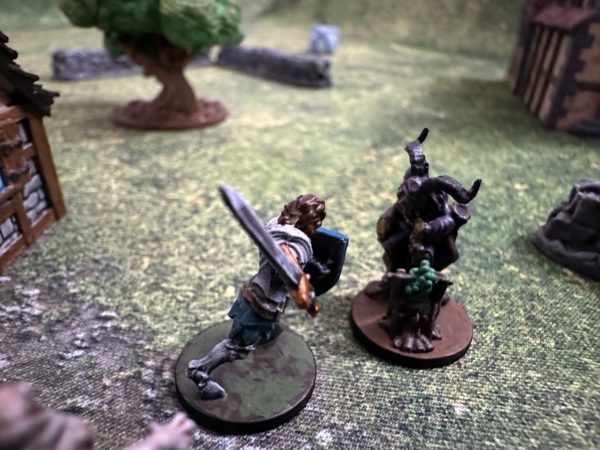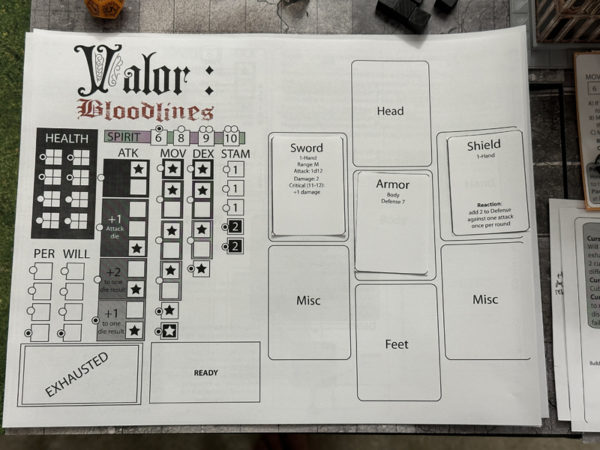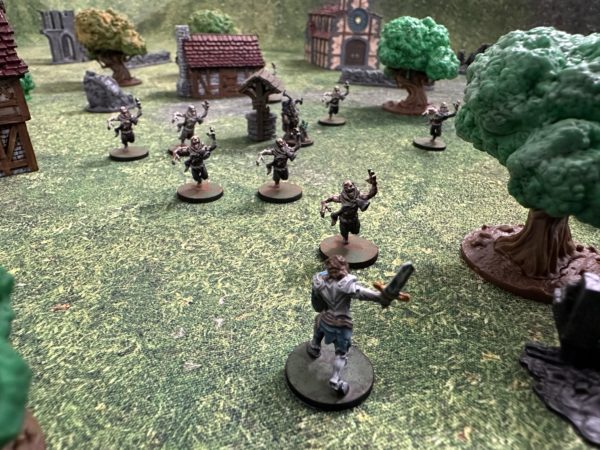With the name Valor: Bloodlines set, I feel like the game is gaining legitimacy in my mind. The concepts are coming together and I’m going beyond core mechanics to the actual shaping of the game and its overall narrative. I have the sketches of both the beginning of this adventure and its end in mind so I’ll begin with the game’s prologue: The Witch Hunt

As I’ve stated early in the endeavor, I want a grand and epic feel, a larger narrative force at work. One mechanical tenet is in the models themselves where each monster needs to be bigger than the hero and progressively get bigger until the hero is facing down truly gargantuan foes. But some rules are meant to be broken and this will happen at the beginning of the game when you face your first foe, the Witch.
This hunt will act as the prologue for the player: a way to introduce both the world and story they are about to engage in as well as guide them through their first game. I’m still debating but I like the concept that the board game Root laid out. In that game, you set up and preload the first 2 rounds of the game with no decisions made by the actual players, they basically run their game as a demo, seeing the rules as they would come up organically. After those first two rounds, the game then takes off the training wheels and lets the players finish out the game using the skills they learned. It is a novel idea in a board game, a learn-by-doing approach that has been a staple of video games for decades now. I plan on something similar to help players immediately jump in.

With a revamp of the hero board, we have the starting hero layout with all their options and weapons. A very basic set up with several limitations in place that I didn’t have before when experimenting with the Werewolf hunt. Same 4 health blocks but we are down now to 6 spirit, limiting ourselves to six action cubes. 2 movement is woefully short (I’ll deal with that in a minute) but also heroes will always have one movement available for no action cube. The standard 4 stamina to recover quickly, one Perception, one Will, one Dexterity, and one Attack. The equipment is the standard sword and board that I’ve been using throughout.
In this board we also see the equipment layout. For now, I have it in my ideal product state with cards representing equipment and the idea of your Keep’s Armory being a stack of cards you eventually acquire. Before the Hunt, you select items from your Armory and put them into the equipped slots. Future iterations may rearrange this but I like the tactile feel of using cards to outfit your hero for battle. The downside is cards are expensive and can be a tall ask for players to either print out and create or buy in addition to the rules. Currently, that is irrelevant as this game is ultimately for me. If I put it out for free on some gaming site or as a download here on the blog, then I guess it is for the player to decide on if they want to invest that much time to play this game.
However, if I ultimately shop this game around, publishers may not like a required card element so I may develop some back up alternatives. This goes for the main AI mechanic as well as that is highly card driven. A lot of this is very much cart-before-the-horse but still something I’m keeping in mind as I go through all of this.

With a new monster, we have to have a new Witch board. We have the Witch powers which revolve around curses she can place on the hero. These require no line of sight or distance, they just happen and are triggered by the AI cards.
Next we have the Witch stats with everything a bit lower than the Werewolf: health, movement, defense, and damage. The environment and setup show us the layout of the board, using the 18″ x 18″ size again. The whole opening of this prologue is the Hero coming to stop whatever unnatural plague is happening in the village, rumored to be spread by some foul creature. Infection will center in the buildings and also act as spawn points for the Witch’s minions, the Plague Victims. There will be a hard cap on the number of spawned minions in play (this will always be the case in this game as having no cap gets annoying for players at a practical level). Lastly, 2 move for the hero is a balancing decision to give the hero room to grow and cater to the kind of character the player wants to build. But a max of 2 inches is brutally slow and limits a lot of the dynamic options for the enemies, making for a pretty boring scenario. The “cobbled ground” rule doubles the distance back to the normal 4 inch max that I’ve been using as a standard.

The Plague Victims are a new basic minion type that will likely only see play in this prologue. They are very basic with a mindless zombie-type AI. They can be easily avoided but will overwhelm you in large groups. I have no reaction listed for them but everything in the game will have a standard reaction to be able to gain a free attack against anything leaving an engagement. Their power helps weaken the hero by limit their ability to recover action cubes.

To get everything ready, I needed to paint up the Witch, her nine minions, and three buildings. The Witch and minions were easily slap-chopped with washes and contrast paints but the buildings took a bit of work. Airbrushing and washes helped but all the beams and wood took a bit of time. The effort was well worth it as the village starts to come to life.

But maybe not exactly the way the hero hoped. Next time, we’ll see how both the hero and designer fared in this initial outing.
